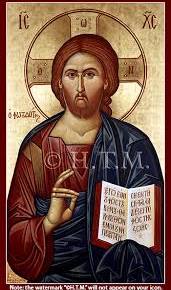

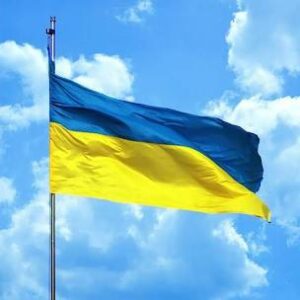
Saint Theodora of Thessaloniki
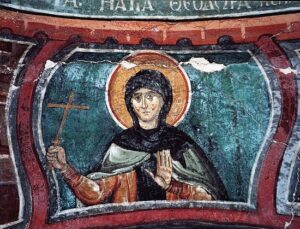
I’ll try to explain this Post’s title later.
My Unplanned Visit to Saint Theodora
It was during my 2002 trip to Mount Athos. I had an afternoon free in Thessaloniki * , before catching the boat to the Holy Mountain the next morning. I wandered around amazed: an Orthodox church about every six blocks, just like the Lutherans here in Cedarburg, except these churches were large and open, and people were going in and out, lighting candles and praying. It was beautiful.
- Θεσσαλονίκη: often Anglicized into “Thessalonica” or “Salonica” because… because that’s what the English do.
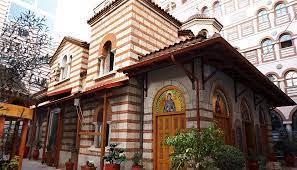
Mid-afternoon I happened upon a small church, the lovely immaculately kept men’s monastery Church of Saint Theodora near the seafront (squeezed among tall buildings, so there’s no way to get a good picture of the exterior), where lie her relics. * The interior of the church is gorgeous, but it was more than that. Perhaps it was the presence of the saints *, about whom at the time I knew nothing. Whatever the reason, I could not bring myself to leave the place. I sat there not exactly praying, just being quiet, very still, for I don’t know how long – it was well over an hour – till someone said “We’re closing, mister”.
- It is also the earthly resting place of Saint David the Dendrite (tree-dweller) of Thessaloniki who perched in an almond tree till God told him to come down. While I was in the church I knew nothing of David. Years later I had forgotten he was there, but I found him becoming one of my favorite saints, for reasons I couldn’t explain. I bought an icon of him and began to ask his prayers. I thought this very odd, inasmuch as I’m afraid of heights. Now I understand. He caught hold of me that afternoon at Saint Theodora’s. God’s holy ones have very mysterious ways of working on us. If you’d like to know more about this fascinating Dendrite, go to my Blog Post 82, which you can access at the very end of this Post.
Saint Theodora’s Church is well worth seeing for yourself. Go to: https://pemptousia.com/accessible-photo-gallery/?ph=37710
But which Theodora?
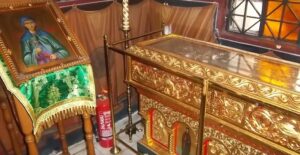
Ever since that visit in 2002, I’ve felt a special closeness to Saint Theodora. The problem (of which I’ve just now become aware) is: There are apparently two Saint Theodoras * of Thessaloniki. Which Theodora’s relics lie in Saint Theodora’s church? Which Theodora have I been attached to? As I’ve researched this, the answer has become murkier.
- plus a multitude of Theodoras from other places
Now, hang on tight and try to follow.
The Saint Theodora of Thessaloniki whose commemoration falls on April 5 gets ignored during Lent, for the obvious reasons
The other Saint Theodora departed this earthly life on August 29, the day we commemorate the Beheading of Saint John the Baptist. So she wouldn’t get lost, she was long ago transferred to August 5 by the Greeks (though to August 3 by the Russians), which didn’t help much. Those dates fall during the time of preparation for the Dormition of the Theotokos, so she also gets ignored. Pity the poor holy Theodoras of Thessaloniki, which is one reason why I’m writing about them now.
However some say there was only one of them.
Are you still with us? I’m not sure I am. I hope nobody ever told you the Orthodox religion was simple.
But keep reading. If we hear the stories of these holy women, perhaps things will become. clearer.
#1) Saint Theodora of Thessaloniki – April 5
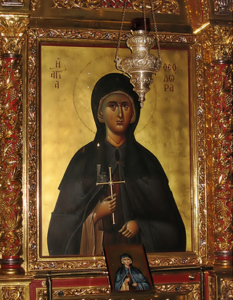
I hope Orthodox Wiki (orthodoxwiki.org) won’t mind my borrowing their succinctly written account.
“The Venerable Theodora of Thessalonica, [Greek: “gift of God”], was a nun who lived a pure and blameless ascetic life. She is commemorated on April 5.
“Nothing is known of Theodora’s birthplace and date, youth, and early life. From her youth she loved Christ. Desiring to leave worldly pursuits behind, she entered a woman’s monastery. There she kept a virtuous and ascetic life, being obedient to the abbess and all the other sisters. Her obedient nature even showed after her death.
“The abbess fell asleep in the Lord many years after the sainted Theodora. When the grave for the abbess was dug, the relics of Theodora were uncovered. Her relics appeared to have moved in order to make room for the abbess’ body. This caused a reaction among those who witnessed the remarkable event to cry out, ‘Lord have mercy!’
“Many who came to venerate her were healed of all manner of diseases or freed of the power of demons. Many miracles occurred through the holy relics of St Theodora.
“The story of St Theodora was recorded in 830, by St Joseph the Hymnographer. ”
This was written apparently not long after her death, though I can’t find that date anywhere.
One of the miracles which caught peoples’ attention involved an oil lamp at her tomb which for many days refused to go out, though there was no oil left. Then finally, all on its own, it overflowed with oil.
In my previous Protestant existence I was very skeptical of stories like this. That was before I saw two weeping icons for myself.
#2) Saint Theodora of Thessaloniki: originally August 29

…but, as I said, transferred to August 5 by the Greeks, and to August 3 by the Russians
This Theodora’s “hagiography” was written by one Gregory the Presbyter.
Theodora was a native of the island of Aegina, just off Athens, born to a devout family. Her father was a priest, a brother a deacon and her sister became a nun. She was given in marriage to a nobleman of Aegina. Life on Aegina then became so disturbed by Saracen pirates, to the point that the island was abandoned. Theodora’s brother was killed. Theodora and her husband and father fled to the safety of Thessaloniki where they had relatives deeply involved in the life of the Church: A cousin Ekaterini was abbess of the Monastery of Saint Luke. Another brother (?) was briefly the Bishop of Thessaloniki. Theodora became mother of three children.
Following the death of two of their children, Theodora dedicated her third child Theopiste * to the monastic life. She was tonsured at the monastery where her cousin was abbess. Then Theodora’s husband died, and she was alone. She divided her wealth between the poor and the monastery and joined her daughter in the monastery.
- “faithful to God”
For fifteen years mother and daughter worked and prayed together. Then her daughter Theopiste was named abbess (gerontissa) of the monastery. Theodora continued life in the monastery faithfully, oddly under obedience to her own daughter. Other than that, nothing about her seemed especially noteworthy.
Theodora died on August 29, 892. Some time after she died, and for reasons not explained, it was decided that her body should be translated from the communal tomb of the nuns to a separate sarcophagus – perhaps to the site of the present Saint Theodora’s Church? Her biographer Gregory, with a group of people, went to her grave but they were unable to move away the tombstone. After prayers, about midnight, inexplicably they were now able to move the stone. When they placed Theodora’s body in the sarcophagus a heavenly fragrance began to arise, and oil (myrrh) began to flow from her relics. Like Saint Demetrios, also of Thessaloniki, and Saint Nicholas of Myra, Saint Theodora of Thessaloniki became one of the Church’s myrrh-streaming saints. There were miracles, including the healing of Gregory’s own sister.
Several sources provide this story: “Saint Theodora’s body was placed in Saint Theodora’s’ Church. After the invasion of Thessaloniki, the Turks broke into the sarcophagus with the relic, and cut it in pieces. The pilgrims put all the pieces of the relic together. Then, they put it back in its place.” saloniki.guide
So which Theodora lies in Saint Theodora’s Church?
Some say there was only one Theodora. For example: “Her memory is honoured on the 5th of April and the 3rd of August.” artisgr.shop Both the Greek Orthodox Archdiocese in America and the Orthodox Church in America, in their daily listing of the lives of the saints, provide only one biography for both days.
But why then the two dates? And, as you’ll remember, each Theodora had a different contemporary hagiographer and hagiography.
Let’s move on. A little background about the church: The ancient Church of Saint Theodora was leveled once by earthquake and rebuilt. All except the tower was destroyed again in the Great Fire of 1917 which consumed much of the city. Then today’s modern church was built.
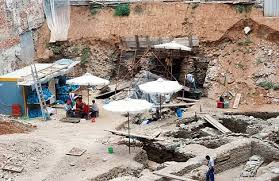
From Wikipedia: “Her cult continued during the time of the Turkish occupation and it still continues today in the modern church of St. Theodora which is now part of a male monastery. In August 2010, archaeologists in Thessaloniki discovered a tomb that they tentatively identified as that of Theodora as previously a large three-aisled basilica dedicated to Theodora had been found next to the tomb.” (This is from the well-documented Wikipedia article “Theodora of Thessaloniki”)
So was this (above) the original resting place of the one Saint Theodora, from which she was moved (as described above (by the Priest Gregory) to her present Church of Saint Theodora? Or is this another Saint Theodora?
Enough. I’m still completely confused, and I’m sure you are completely bored.
If there are any Theodoraphiles here present, can you set this straight?
Quick Solution
All I know to do are the following:
1 Every morning I ask: “Saint Theodora, pray for me”, and trust our Lord Jesus to sort it out.

2 Every once in a while, I imagine myself back in that little Church of Saint Theodora, sitting again in the stillness of that lovely holy place. I should do this more often.
Next Week: The Eve of Lazarus Saturday, the first of our annual twice-daily Posts which will continue through Pascha afternoon Agape Vespers.